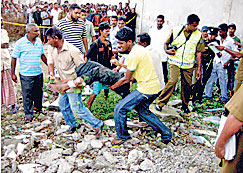As the police continue to crack down on criminal gangs, “unidentified groups” are taking the law into their own hands and carrying out vigilante killings – a development that is causing grave concern among human rights groups.
Despite the escalation of abductions, killings and multiple homicides, little or no official information about the groups responsible for the killings has been forthcoming.

The past two months have seen a series of gangster-style killings of underworld figures. |
June and July were particularly bloody months, with the crime rate rising to unprecedented levels.
Meanwhile, some believe that both the police and the underworld are dispensing shotgun justice and playing the roles of judge, jury and executioner.
According to a recent Asian Human Rights Commission (AHRC) report, in the past year more than 100 murder suspects died while in police custody.
For their part, the police say suspects in custody bring about their own deaths by attempting to escape or attack the police. The usual scenario is of suspects turning on the police when they are escorted to identify weapons, narcotics and contraband: the suspect attempts to break free by lobbing a grenade at the police and is consequently shot dead. There are also stories of murder suspects committing suicide while in police custody.
In the first half of 2008, the police recorded 28,257 incidents of grave crime, including homicide, abduction, rape, extortion, and drug-related offences. Of these, 8,346 cases have been settled, 19,800 cases are pending, and 7,253 cases are under investigation.
Against this gory background of mafia-style killings comes more violence in the form of homicidal attacks on families. In a period of three weeks the police recorded three cases of triple homicide involving family members. The killings took place in Nuwara Eliya, Horana and Nawalapitiya.
Three days after the June 30 Horana triple homicide, in which a father, mother and daughter were hacked to death, the prime suspect was found dead, with his hands and legs tied. According to the police, the suspect was abducted by unidentified persons who had tortured him before slitting his throat and dumping his body in a rubber estate. The suspect had been out on bail on charges of rape, the police said.
The Horana incident is just one in a string of incidents in which the main suspect has been abducted and violently disposed of. Police say they have recorded more than 10 cases in one month of notorious gang members linked to killings, abductions, extortion and drug trafficking going missing and ending up as murder victims.
One incident that made headlines recently was the killing of Aanamalu Imtiyaz, a notorious Maligawatte gang member whose bullet-riddled body was found dumped in a street in Pettah. According to the police, the victim was abducted in Kuliyapitiya four days earlier by armed men travelling in a van.
The same day the bullet-riddled body of another leading gang member, Muhamed Nisthar, also previously abducted, was found dumped in a street in Grand Pass.
According to sources, Aanamalu Imtiyaz’s big rival in the Maligawatte underworld is Faji, who is still at large.
On July 14, the body of another gang leader, Mohamed Anver, said to be a buddy of Faji, was found in Biyagama. Anver had also been abducted.
The latest incident of a gang leader being abducted and killed was reported from Kirulapone last Tuesday. The victim was taken from his home in Dehiwala by unknown persons.
The same day the bullet-riddled body of the main suspect in the killing of Danny Hithetiya, former chairman of the Southern Development Authority, was found in a ditch in Walawila Godella.
According to sources, these abductions and killings are believed to be the work of a group of persons known as the “unit.” Little or nothing is known about the elusive unit.
Meanwhile, human rights organisations are laying the blame for the spate of abductions and killings on the police.
Chitral Perera, secretary of human rights organisation Jana Sansadaya, told the Sunday Times that the police were taking the law into their own hands. “The issue here is that the police are doing just as they like,” Mr. Perera said. “Their job is to apprehend criminals and produce them in court. The court decides whether a person is guilty of a crime or not. But this is not the way things are going.
“When a suspect is shot by the police, the case is not investigated. It is treated as justifiable homicide. This is a dangerous trend that could put innocent people’s lives in danger. A suspect is innocent until proven guilty in a court of law.”
According to police spokesman SSP Ranjith Gunasekara, the police are authorised to kill any person who threatens the lives of others, including police officers.
“These men are armed and extremely dangerous,” SSP Ranjith Gunasekara said. “When cornered, they will do anything. In most of these cases, the police have acted in self-defence. There is evidence that the suspects intended to harm police officers. The police have no alternative but to shoot.”

|


